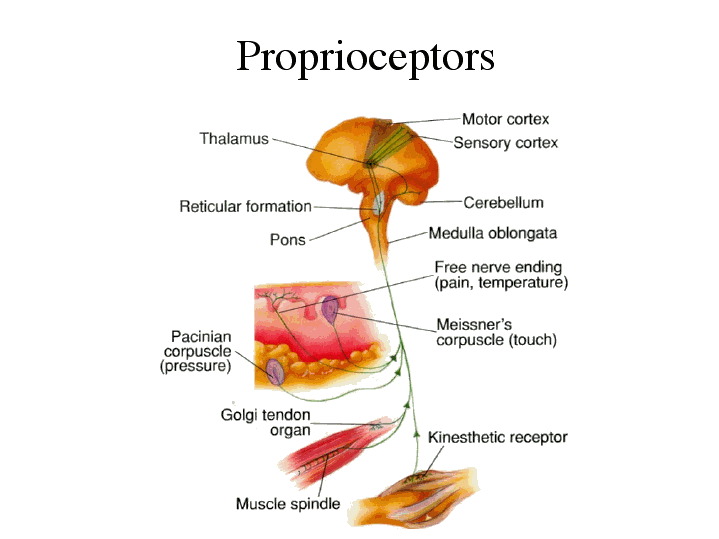Proprioception, Proprioceptive System, and Proprioceptors
DISCLAIMER: Don't be scared by the title, keep reading and I promise it will all make sense.
Now that we have that out of the way, I think many people regard the human body as the most complex organism in the universe...ok maybe not the entire universe, but you catch my drift. Nevertheless, the body is indeed the most complex organism in humanity's universe. (There, now Neil deGrasse Tyson would approve.) 😉
Given how profoundly sophisticated the body is, ESPECIALLY the nervous system - understanding it is no simple task. Most people are unaware of the inseparable relationship between their spine and nervous system, forget about comprehending how the mechanism of an adjustment can change the brain.
But the veil hiding the nervous system's deeply-held secrets is even more impenetrable when the language we use to talk about it is itself perplexing. One of the most significant barriers to learning in all branches of science is the convoluted vocabulary. Cue how you might have felt from just immediately trying to read the title...am I right? I'm personally having flashbacks from my childhood years and trying to pronounce dinosaur names...I'm talking THAT feeling.
Today's newsletter will address three terms that have a lot to do with your nervous system and your chiropractic care:proprioception, proprioceptive system, and proprioceptors. Stick with me, I got you.
Proprioceptionis a sensation within the body that allows it to gather data about the state of its parts relative to each other and the external environment. The strict definition of the term refers to the body's ability to sense movement and joint angles. However, depending on the source, "proprioception" may be applied to describe the body's general sense of self-awareness, incorporating vision, the vestibular system (structures within the ears aiding in balance and spatial awareness), interoception (internal body feelings), and even intuition (your inner "Spidey" sense). Put simply, it's your brain's ability to know where your body is at all times without you needing to worry about it.
The sensation of proprioception is provided by theproprioceptive system, which is the collective name for highly specialized sensory organs located throughout the musculoskeletal (muscles and bones) system. All proprioceptors belong to a class of neural (nerve) structures calledmecahnoreceptors, which simply means they convert mechanical stimuli like compression and stretch into action potentials. When a joint or several joints move, the surrounding tissues are distorted. Such distortions include shortening and lengthening in different directions and magnitudes, leading to contrasting patters of contraction and stretching of the tissues relative to direction and range of motion. Here's an easy example to explain: when you flex/bend your elbow, the tissues on the front of the upper arm shorten while the tissues on the back of the upper arm lengthen. These opposing mechanical states are detected by proprioceptors (but you know that already), which relay information to the central nervous system (brain and spinal cord) about the amount and direction of joint motion. Pretty cool huh?
** Side bar alert: If you’re still with me, how many of you instantly thought of Adam Sandler from the “Water Boy” when you read medulla oblongata from the photo above? It can’t be just me right?!? **
Ok, ok back to business. Proprioceptors are the sensory organs that each respond to a very specific type of stimulus. Important proprioceptors include:
Muscle spindles - which detect speed and amount of muscle stretch.
Golgi tendon organs - which detect amount of muscle tension.
Joint receptors - which detect motion ONLY at the extremes of physiological motion.
Free nerve endings - which detect potentially harmful stimuli.
Cutaneous receptors - located in the skin, not muscle. These detect pressure, vibration, skin stretch, temperature and pain.
The structure and function of these receptors are too elaborate to get into but you've got the basics and then some. All of these proprioceptors are stimulated when you get your chiropractic adjustments. In fact it's well studied that proprioception can power down nociception (pain). Ever notice that a "pinch" or complaint you had immediately went away after your adjustment, this is part of the reason why.
To summarize instead of taking you down a black hole of neuroanatomy and physiology: proprioceptors are highly specialized nervous system structures located in your muscles, tendons, joints, ligaments, and skin. They relay important information to the central nervous system about what the body is doing and where it is in space. They are collectively known as the proprioceptive system. Proprioception is the sensation that arises from the nervous system processing their combined inputs.
Boom, look at you being all smart and stuff. I hope this helps you all to understand a little bit more about what happens when you get adjusted. Most importantly, I hope that it didn't make these words seem so intimidating.
The human body is truly incredible isn't it?

